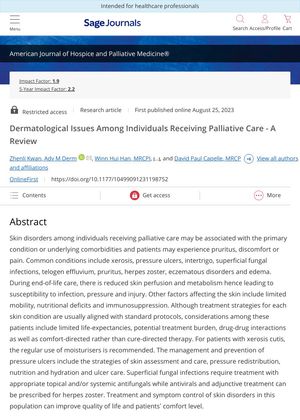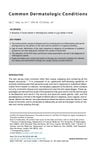Dermatological Issues Among Individuals Receiving Palliative Care - A Review
August 2023
in “
American Journal of Hospice and Palliative Medicine
”
telogen effluvium xerosis pressure ulcers intertrigo superficial fungal infections pruritus herpes zoster eczematous disorders edema immunosuppression moisturizers antifungals antivirals dry skin bed sores skin yeast infection itching shingles eczema swelling immune suppression skin creams fungal treatments viral treatments

TLDR People in palliative care often have skin problems due to their main illness or other health issues, and treatments focus on comfort and quality of life.
The review discusses skin disorders in individuals receiving palliative care, which can be associated with the primary condition or underlying comorbidities. Common conditions include xerosis, pressure ulcers, intertrigo, superficial fungal infections, telogen effluvium, pruritus, herpes zoster, eczematous disorders, and edema. Factors affecting the skin include reduced skin perfusion and metabolism, limited mobility, nutritional deficits, and immunosuppression. Treatment strategies are usually aligned with standard protocols but are adjusted considering patients' limited life-expectancies, potential treatment burden, drug-drug interactions, and the focus on comfort-directed rather than cure-directed therapy. Regular use of moisturizers is recommended for xerosis cutis, while pressure ulcers management includes skin assessment and care, pressure redistribution, nutrition and hydration, and ulcer care. Superficial fungal infections require treatment with appropriate topical and/or systemic antifungals, and antivirals and adjunctive treatment can be prescribed for herpes zoster. The treatment and symptom control of skin disorders can improve the quality of life and comfort level of patients.








